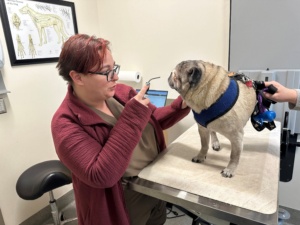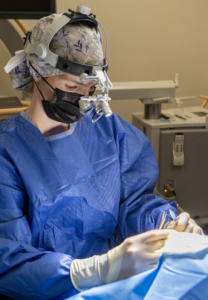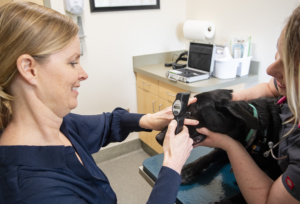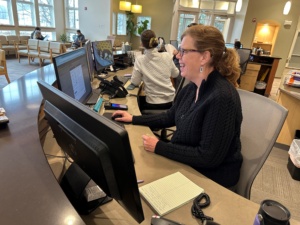As pet parents who want the best for their furry family members, ensuring their well-being extends beyond providing love, nourishment, and yummy treats. It also involves protecting their physical health, including their eyes. From understanding potential risks to implementing preventative measures, join us as we dive deeper into protecting your pet’s eyes from injuries and maintaining optimal ocular health.
Recognizing the Signs: Eye Health Red Flags
How do you know if your dog or cat needs to get their eyes checked? It’s more than trying to figure out if their vision is clear. If you notice your pet displaying any of these symptoms or characteristics, be sure to see a veterinary ophthalmologist.
- Cloudiness to the eyes
- Eye color change
- Eye swelling
- Injury/trauma
- Mucus discharge
- Redness
- Squinting
- Tearing/weeping
- Vision behavior change
- Your pet is bumping into things (vision loss indicator)
- Your pet is holding their eye closed or is reluctant to open their eye/eyes
A veterinary ophthalmologist will be able to decipher the root of the issue and provide a treatment plan that works best for you and your pet.
Keeping Your Pet’s Eyes Healthy
With a proactive approach, pet parents can contribute to a lifetime of optical well-being. Incorporating simple yet effective practices into your routine can go a long way in maintaining those bright, expressive eyes.
Regular Eye Checks. A fundamental first step, make sure you bring any issues and concerns to your veterinarian, especially if you notice any changes in color, discharge, or cloudiness.
Balanced Diet. We’ve all been told to eat carrots to protect our eyes from disease, and the same goes for our pets! A balanced diet rich in essential nutrients like omega-3 fatty acids promotes strong ocular health.
Watch Out for Irritants. Regularly wiping their pet’s face with a damp, clean cloth helps remove any accumulated dust or debris that could potentially irritate them. When bathing, using a pet-friendly, hypoallergenic shampoo ensures that harsh chemicals are kept at bay. If your pet enjoys outdoor activities, consider protective eyewear like dog goggles to shield their eyes from wind, dust, and UV rays.
Limit Chance of Injury. Create a safe environment in your home to make sure that any sharp edges are concealed and out of reach. Trim your pet’s nails regularly to avoid and prevent any accidental scratches.
Ophthalmology at BEVS
Top-notch eye care means having skilled veterinary ophthalmologists as part of your pet’s healthcare team. Sarah Hoy, DVM, MS, DACVO, and Courtenay Brines, DVM, MS, DACVO–our highly trained and compassionate board-certified veterinary ophthalmologists–bring years of experience in diagnosing and treating a wide range of animal eye conditions. From routine eye exams to complex surgical procedures, BEVS has you covered.
Meet the BEVS Ophthalmology Team
We asked our ophthalmology team some fun questions (1. What is your favorite pizza topping? 2. What is your favorite thing about working in ophthalmology? 3. What pets do you have at home?) so you can get to know them better. Check out their answers below!
 Ashlie, Ophthalmology Technician
Ashlie, Ophthalmology Technician
1. Onions, pickles, and pepperoni
2. Cat eyeballs are very unique and can do unusual things
3. 3 dogs (Ruthie, Odafin Tutuola, and Jolene) and a 5-year-old human child
 Marie, Ophthalmology Technician
Marie, Ophthalmology Technician
1. Pineapple and ham
2. Building relationships with clients and patients, following cases, and easing discomfort
3. 1 Pembroke Welsh Corgi, 1 Cardigan Welsh Corgi, and one normal black cat
 Courtenay Brines, DVM, MS, DACVO (Veterinary Ophthalmologist)
Courtenay Brines, DVM, MS, DACVO (Veterinary Ophthalmologist)
1. Clam and white sauce from Pepe’s in New Haven, CT
2. Eyes are tiny but complex, and can be an indicator of systemic health. I also appreciate that there are both surgical and medical treatments for eye disease.
3. 3 dogs (Catahoula, ChiWeenie, and York) and one cat
 Sarah Hoy, DVM, MS, DACVO (Veterinary Ophthalmologist)
Sarah Hoy, DVM, MS, DACVO (Veterinary Ophthalmologist)
1. Black olive
2. The eye is fascinating in that it is the designated biological camera that turns light into a picture for the brain to process. When the camera isn’t functioning correctly or is damaged, the picture is blurry or dark. By treating our patients, we keep them comfortable and improve or restore vision. It is a delight to witness return of vision and ocular comfort and the resulting improvements in the pet’s quality of life.
3. Swix the English Pointer, Shelby the Golden Retriever, and numerous chickens
 Ruth Van Horn, Receptionist
Ruth Van Horn, Receptionist
1. Pepperoni, olive, and mushroom
2. Working in person with a small ophthalmology team.
3. Linus, a 3-year-old Chocolate Lab

